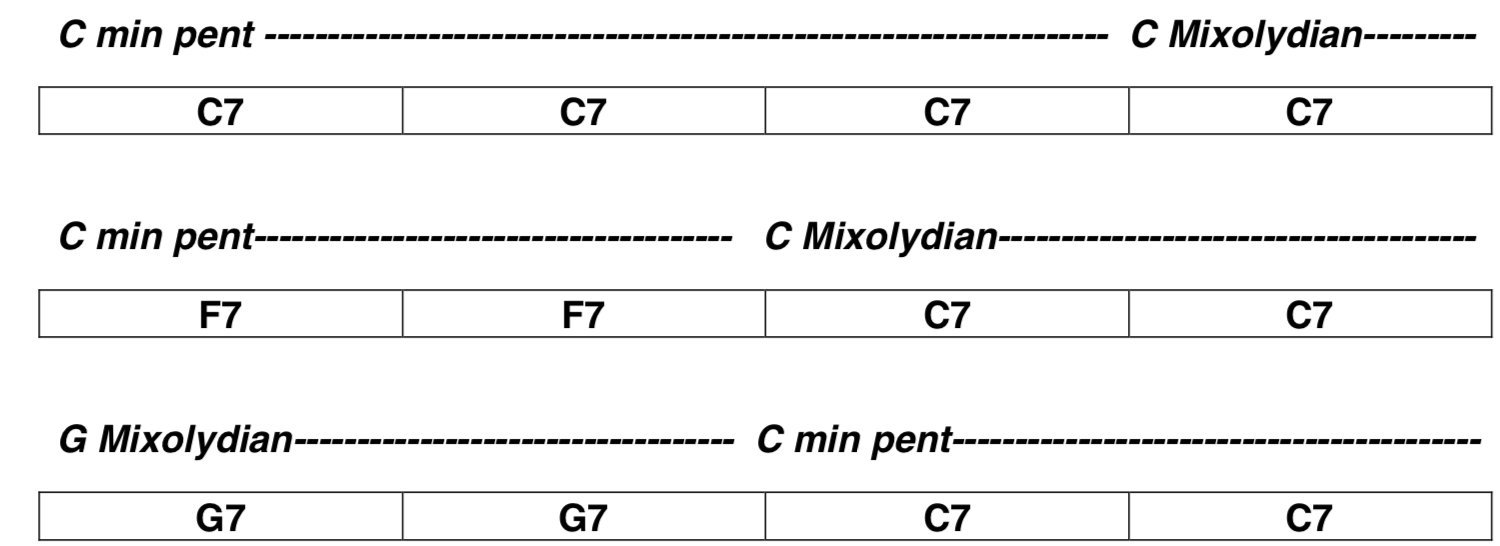Mixolydian and the minor Pentatonic
Mixolydian and the minor Pentatonic
When faced with improvising over a dominant seventh chord or a progression of dom7’s, many guitar players tend to resort to the minor or the Blues pentatonic as their default tonal material. Especially in a “bluesy” context, such as a standard Blues progression, this works very well and the straight forward structure of the pentatonic allows plenty of room to think about phrasing, timing, tone and all the other musical parameters that go beyond harmonic material.
However, integrating the Mixolydian scale into your harmonic repertoire will add a whole new musical component to your solo playing and, especially in combination with the minor pentatonic, can make your solos sound a lot more exciting and engaging to the listener!
Constructing the Mixolydian scale
Mixolydian is the fifth mode of the Ionian system. This means that if you’ll play the Ionian (major) scale from its fifth note onwards – thinking of that fifth note as the new root – you will end up with a Mixolydian scale.
Take for example C Ionian ( C D E F G A B C ) and play it from its fifth note G onwards, up to the next G – this will give you G Mixolydian ( G A B C D E F G). The numbers above the tab below tell you which degree of the scale each note represents:
C Ionian
G Mixolydian
If you’d like to read more about the Ionian System and its modes, have a look here: https://londonguitaracademy.com/seven-modes-of-the-ionian-system
For the most part, the Mixolydian scale is identical to the Ionian scale, except for one crucial detail: While Ionian has a major 7, Mixolydian has a minor 7, making it the perfect scale for Dom7 chords, which – just as the Mixolydian scale – contain a major third and minor seventh.
So, another easy way of constructing Mixolydian scales is taking a major scale and simply lowering its seventh note by a semitone. In the following examples, we’ll expand the scales over several octaves covering all six strings to give you a practically useful pattern for each scale.
C Ionian
C Mixolydian
Note that the difference between C Ionian and C Mixolydian is their seventh note (B and Bb).
Combining Mixolydian and the minor pentatonic
As mentioned earlier on, a strong way of incorporating the Mixolydian scale into your solo is combining it with the minor pentatonic, as this brings out the characteristics of each scale. Let’s have a look at which notes the two scales have in common and which notes make up the differences:
C minor pentatonic
C Eb F G Bb C
C Mixolydian
C D E F G A Bb C
The main difference – apart from the obviously different amount of notes that each scale is made up off – is the major third in Mixolydian opposed to the minor third in the minor pentatonic. This minor third played on a Dom7 chord (which itself inherently has a major third) is what makes it sound “bluesy” and somewhat wailing, and is an important stylistic device in Blues improvisation. Using the major third of Mixolydian will give you a brighter sound, bringing out a different shade of the Dom7 chord you’re improvising on. The major second and sixth of Mixolydian further add to that brighter sound, the rest of the notes (1 4 5 7) are identical to the pentatonic. In the following example on a C7 chord we’ll combine the two scales – note how the feel gets brighter once we switch to Mixolydian in bar 3 (not counting the pick up bar)!
Every Dom7 chord has its own respective Mixolydian scale. When the chord changes from C7 to F7 in our Blues progression, the Mixolydian scale of the moment would now change to F Mixolydian as well.
A strong way of navigating through those chord changes without “merely” jumping from one Mixolydian to the next, is to alternate between the minor pentatonic of the key (C min pent) and the Mixolydian scale of the moment (C, F or G Mixolydian).
A great exercise to practise this is to write out the chord progression your are improvising on and to mark in which tonal material you’ll use in your solo at what point. An example could look like this:

As you can see, there are almost endless possibilities of when to use which scale and it is great practice and a lot of fun to experiment with different combination of those scales and to listen to how the sound and feel of your solo changes!
The Mixolydian Pentatonic
At the end of this article, I’d like to show you hybrid between the minor pentatonic and the Mixolydian scale: The Mixolydian Pentatonic, which just as the minor pentatonic (and every other pentatonic for that matter – that’s why they call it pentatonic) consists of five notes. We can easily construct that scale by simply turning the minor third of the minor pentatonic into a major third:
|
C7 |
C7 |
C7 |
C7 |
|
F7 |
F7 |
C7 |
C7 |
|
G7 |
G7 |
C7 |
C7 |
This scale contains the “essence” of the Mixolydian sound and, due to its structural similarity to the minor pentatonic, is a great gateway from the minor pentatonic towards the Mixolydian scale!
